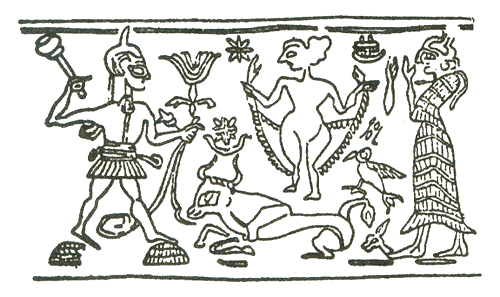 |
| Asherah |
| Depiction of Josiah "cutting down the statue of Asherah" |
Did God Have A Wife?
Dever, who is Professor Emeritus of Near Eastern Archeology and Anthropology at the University of Arizona, claims this ancient goddess was a part of the Canaanite pantheon before 600 B.C.
Depiction of Asherah
holding court
|
For more information, please visit:
http://en.wikipedia.org/wiki/William_G._Dever
 |
| Dr. Francesca Stavrakopoulou |
The first historian to mention and bring to light the subject of the ancient Israelites worshiping both Yahweh and Asherah was Raphael Patai in 1967. The theory gained new prominence in the 21st century when Professor Francesca Stavrakopoulou, a senior lecturer in the department of Theology and Religion at the University of Exeter, presented her research which discussed the Yahweh-Asherah connection. The information presented in Stavrakopoulou's books and lectures has become the basis of a three-part series on the BBC entitled, The Bible's Buried Secrets. Stavrakopoulou is quoted as saying:
"You might know him as Yahweh, Allah or God. But on this fact, Jews, Muslims and Christians, the people of the great Abrahamic religions, are agreed: There is only one of Him," writes Stavrakopoulou in a statement released to the British media. "He is a solitary figure, a single, universal creator, not one God among many … or so we like to believe."
 Dr. Stavrakopoulou, a self-proclaimed atheist, claims that God had a wife and her assertions are backed up by archaeological evidence including 8th century B.C. inscriptions, figurines and ancient texts that were discovered at Kuntillet Ajrud in the northern Sinai desert. These texts are known as the Ugaritic texts (written before 1200 B.C.) and refer to "Yahweh... and his Asherah". The inscriptions found not only invoke Yahweh, but El and Baal and include the phrases, "Yahweh of Samaria and his Asherah" and "Yahweh of Teman and his Asherah". Samaria was the capital of the ancient kingdom of Israel and Teman was located in the ancient land of Edom. It remains unclear the association with Edom, considering the national god of Edom was Qaus, but some scholars believe such a connection was most likely cultic in nature. In the Bible, Asherah is represented by the symbol of a tree.
Dr. Stavrakopoulou, a self-proclaimed atheist, claims that God had a wife and her assertions are backed up by archaeological evidence including 8th century B.C. inscriptions, figurines and ancient texts that were discovered at Kuntillet Ajrud in the northern Sinai desert. These texts are known as the Ugaritic texts (written before 1200 B.C.) and refer to "Yahweh... and his Asherah". The inscriptions found not only invoke Yahweh, but El and Baal and include the phrases, "Yahweh of Samaria and his Asherah" and "Yahweh of Teman and his Asherah". Samaria was the capital of the ancient kingdom of Israel and Teman was located in the ancient land of Edom. It remains unclear the association with Edom, considering the national god of Edom was Qaus, but some scholars believe such a connection was most likely cultic in nature. In the Bible, Asherah is represented by the symbol of a tree.For more information, please visit:
http://www.dailymail.co.uk/news/article-1364018/Atheist-Dr-Francesca-Stavrakopoulout-BBC-face-religion.html#ixzz3LSJR8i15
Asherah: Symbol of a Tree
 |
| Depiction of Asherah tempting Eve |
The goddess known as Asherah was represented by a limbless tree trunk which was carved into a symbolic representation of the deity and planted in the ground. Throughout the centuries this association with carved trees were commonly places of Asherah worship. The Hebrew word "asherah" could also refer to a grove of trees... hence the connection. Some scholars even claim that it was Asherah, not Satan, that tempted Eve in the Garden of Eden. The Christian Bible has many references to "Asherah poles", in which case, most were destroyed after 600 B.C. The biblical references include: 2 Chronicles 33:3; Exodus 34:13; Deuteronomy 7:5; 12:3; 16:21; Judges 3:7; 6:25-26; 6:28; 6:30; I Kings 15:13; 16:33; 18:19; 2 Kings 13:6; 17:10; 17:16;18:4; 21:3; 21:7; 23:4; 23:6-7; 23:14-15.
For more information, please visit: http://en.wikipedia.org/wiki/Asherah_pole
Further Evidence Reveals...
| Depiction of Baal |
Asherah was often presented as a consort of Baal, the sun god (1 Samuel 7:4 & 12:10) and was considered a moon-goddess. She was worshiped as the goddess of love and war and was oftentimes linked with Astarte and Anath, other Canaanite goddesses of antiquity. The worship of Asherah was noted for its sensuality, which also involved ritual prostitution; the priests and priestesses of Asherah practiced fortune-telling and divination. It was during the time of Moses that God forbade the worship of Asherah. The Law was specific:
"Do not set up any wooden Asherah pole beside the altar you build to the Lord your God," - Deuteronomy 16:21
 |
| Depiction of Jezebel |
For more information, please visit:
http://www.compellingtruth.org/asherah-pole.html
http://en.wikipedia.org/wiki/The_Early_History_of_God
Asherah, while referred to in the Nevi'im/Old Testament as a "pole", she was once revered as a high deity, the wife of the Most High God. Regardless of her sketchy connection in the Tanakh/Old Testament, Asherah is celebrated as the "Queen of Heaven" by those who believe.
Some theologians contest the validity of Asherah being an actual deity, instead implying that she was a sacred, wooden object employed in the cult of Yahweh during the early ancient history of the Israelites and later decried by reformers [such as Josiah] and destroyed. In the Hebrew Bible, there are 40 references to "Asherah" being a notable object (a pole)... hence the theory of "Asherah" being a cultic item. Even though a handful of those verses imply her being a "goddess" and ancient Canaanite literature refers to Asherah as a proper noun (name), the actual function of the word (Asherah) remains a subject of much debate among the scholars.
Some theologians contest the validity of Asherah being an actual deity, instead implying that she was a sacred, wooden object employed in the cult of Yahweh during the early ancient history of the Israelites and later decried by reformers [such as Josiah] and destroyed. In the Hebrew Bible, there are 40 references to "Asherah" being a notable object (a pole)... hence the theory of "Asherah" being a cultic item. Even though a handful of those verses imply her being a "goddess" and ancient Canaanite literature refers to Asherah as a proper noun (name), the actual function of the word (Asherah) remains a subject of much debate among the scholars.
Only one question can sum up this incredible story.... Who's ? Right

3 comments:
Thank you Ms Warman-Stallings for your erudite article. can you provide context for the depiction of "Asherah holding court" (time and place). I have Dever's, "Did God Have a Wife?", but I cannot find it in there.
Cheers, Philip Carter
Hello Philip Carter! You will not find this "depicted" picture in Dever's book as I downloaded it from Google. So I am unable to provide such context. I did try to find this pic again on Google Images, but was unsuccessful. I do remember however, that this particular image had no description assigned to it, other than" "Asherah holding court".... hence my own "depicted" description on Who's ? Right.
Many thanks Kelly, Cheers Philip Carter
Post a Comment